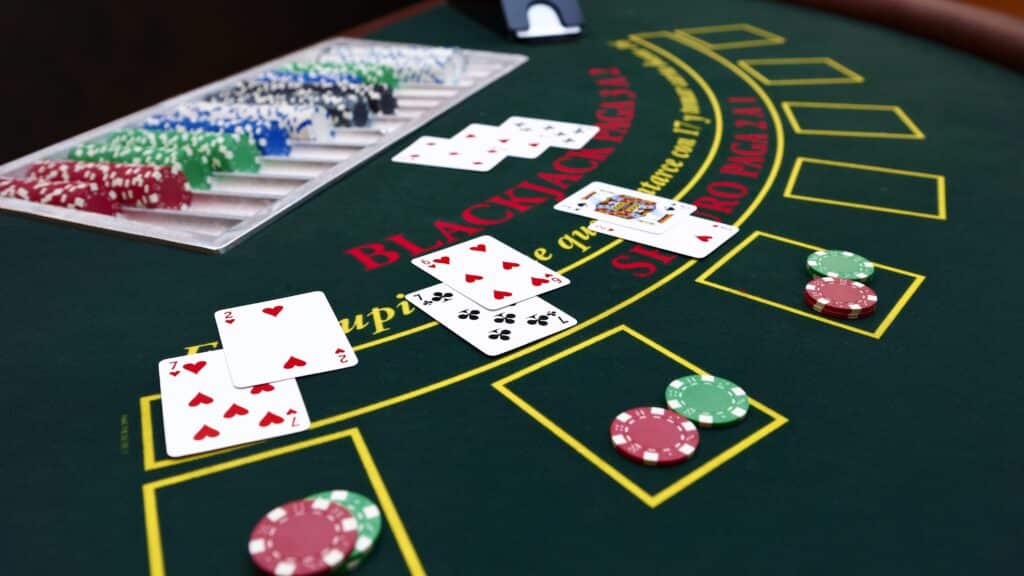Embarking on the thrilling journey of casino gambling, particularly into the world of blackjack, can be significantly enhanced by mastering basic strategy, a cornerstone for both novices and seasoned players aiming to refine their approach to the game.
Understanding Blackjack Basic Strategy
Blackjack basic strategy is not just a set of rules; it’s a mathematically derived approach to playing blackjack that tells you the optimal way to play each hand you are dealt, based on your hand and the dealer’s visible card. Rooted in probability and statistical analysis, this strategy aims to minimize the casino’s advantage, known as the house edge, bringing you closer to even odds against the dealer. For anyone serious about playing blackjack, understanding and applying basic strategy is crucial for making informed decisions at the table and improving your chances of winning. It’s important to note that basic strategy is not a guaranteed win but a method to play each hand in the most statistically advantageous way over the long run.
Core Principles of Basic Strategy
At its heart, basic strategy revolves around understanding a few key actions available to a blackjack player: Hit, Stand, Double Down, Split, and Surrender. Each action has a specific statistical implication depending on the player’s hand total and the dealer’s upcard. Mastering when to employ each of these actions is what basic strategy is all about.
Hit or Stand: The Foundational Decision
The most frequent decision you’ll face in blackjack is whether to ‘hit’ (take another card) or ‘stand’ (take no more cards). Basic strategy provides clear guidelines based on your current hand total and the dealer’s upcard. Generally, you’ll want to hit when your hand is low and stand when it’s high, but the exact thresholds depend on the dealer’s card. For instance, if you have a hand of 12-16, often referred to as a ‘stiff’ hand, you risk busting by hitting, yet standing might mean losing to a dealer’s better hand. Basic strategy charts will precisely dictate when to hit or stand in these borderline situations, optimizing your play to align with statistical probabilities.
Double Down: Maximizing Advantage
Doubling down is an aggressive play that can significantly increase your winnings when used correctly. It involves doubling your initial bet in exchange for receiving only one additional card. Basic strategy advises doubling down when you have a strong starting hand, such as a hard 11, or a soft 16-18 (like Ace-5), especially when the dealer shows a weak upcard (like 2-6). This move is statistically advantageous in these scenarios because it allows you to capitalize on situations where you have a good chance of winning and the dealer is vulnerable.
Splitting Pairs: Separating Opportunities
When you are dealt a pair, such as two 8s or two Aces, you have the option to split them into two separate hands, effectively playing two hands against the dealer simultaneously. Splitting pairs can be beneficial when you have a strong starting pair against a weak dealer upcard. For example, splitting Aces is almost always recommended because it gives you two chances to hit blackjack. Similarly, splitting 8s against a dealer’s card of 2-7 is often advised to avoid being stuck with a total of 16, which is a poor hand. However, basic strategy also dictates when not to split, such as with pairs of 10s or face cards, as these hands already have a strong total of 20.
Surrender: When to Cut Losses
In some blackjack variations, the option to surrender is available, allowing you to forfeit half your bet before any more cards are dealt if you believe you have a very poor hand. Basic strategy identifies specific situations where surrendering is statistically the best option, typically when you have a hard 16 against a dealer’s 9, 10, or Ace, or a hard 15 against a dealer’s 10. Surrendering in these scenarios minimizes your expected loss compared to playing out the hand, aligning with the principle of minimizing losses when the odds are heavily stacked against you.
Utilizing Basic Strategy Charts
To effectively implement basic strategy, players rely on basic strategy charts. These charts are visual guides that provide clear instructions on the best action to take in any given blackjack situation. Organized in a grid format, these charts cross-reference the player’s hand (categorized as hard totals, soft totals, and pairs) with the dealer’s upcard. By locating your hand type on one axis and the dealer’s upcard on the other, the chart directs you to the statistically optimal move: Hit (H), Stand (S), Double Down (D), Split (SP), or Surrender (SU). These charts are the practical application of millions of computer-simulated blackjack hands, offering a distilled, easy-to-use format for optimal decision-making at the blackjack table.
Reading and Interpreting Charts
Basic strategy charts are designed for ease of use, but understanding how to read them is key to their effectiveness. Charts are generally divided into three sections: Hard Totals, Soft Totals, and Pair Splitting. ‘Hard totals’ are hands without an Ace being counted as 11 (or hands without any Ace at all), while ‘soft totals’ include an Ace counted as 11. The dealer’s upcard is typically listed across the top row, and the player’s hand down the side column. When using a chart, first, identify your hand type (hard, soft, or pair). Then, find your specific hand total in the left column and the dealer’s upcard in the top row. The intersection of these will show the recommended action. For instance, in the ‘Hard Totals’ section, if you have a hand of 16 and the dealer shows a 10, the chart will indicate ‘H’ for Hit, advising you to take another card despite the risk of busting, as statistically, standing is a worse option in the long run.
Variations in Basic Strategy Charts
While the core principles of basic strategy remain consistent, subtle variations in rules across different casinos and blackjack games necessitate the use of different basic strategy charts. The most significant rule variations that affect basic strategy are the number of decks used, whether the dealer hits or stands on soft 17 (S17 vs. H17), and rules around doubling after splitting (DAS) and surrender. For example, a game using a single deck might have a slightly different optimal strategy compared to an eight-deck game, primarily due to changes in the probability of drawing certain cards. Similarly, whether the dealer hits on soft 17 significantly impacts player strategy, especially around hands like soft 18. Players should always seek out and use a basic strategy chart that is specifically tailored to the rules of the blackjack game they are playing to ensure they are making statistically sound decisions.
Advanced Basic Strategy Tips
Beyond the fundamental charts, mastering basic strategy involves understanding nuances and advanced tips that can further refine your game and potentially decrease the house edge even more. These advanced tips often involve deeper insights into game rules and psychological aspects of blackjack.
Adapting to Rule Variations
As mentioned, blackjack rules can vary significantly between casinos and game types, and a crucial advanced tip is to always adapt your basic strategy to the specific rules in play. Key rule variations to be aware of include:
- Number of Decks: Games can range from single deck to eight decks. Fewer decks generally slightly favor the player, altering optimal play for certain hands, especially doubling and splitting decisions.
- Dealer Hits on Soft 17 (H17) vs. Stands on Soft 17 (S17): S17 is more favorable to players. In H17 games, players need to be more aggressive, as the dealer is more likely to improve their hand.
- Double After Split (DAS): Games allowing DAS are more advantageous for players. This rule particularly affects decisions on splitting pairs, making it more beneficial to split in more situations.
- Surrender Option: If surrender is offered, knowing when to use it (typically against strong dealer upcards like 10 or Ace when holding a hard 15 or 16) is vital for minimizing losses.
Understanding these rule variations and using the appropriate basic strategy chart for each set of rules is an essential step for advanced play.
Card Counting Awareness
While basic strategy is about optimal play given standard probabilities, card counting is an advanced technique that attempts to track the ratio of high cards to low cards remaining in the deck to adjust betting and playing decisions. Although basic strategy and card counting are distinct, awareness of card counting can subtly influence advanced basic strategy play. For instance, in games with fewer decks, the impact of card removal is more pronounced, making card counting techniques potentially more effective. However, it’s important to note that card counting is complex, requires significant practice, and is often frowned upon or even prohibited by casinos. For most players, focusing on mastering basic strategy provides a solid, statistically sound approach to the game without the complexities and risks associated with card counting.
Psychological Discipline
An often-overlooked aspect of advanced basic strategy is psychological discipline. Blackjack, like all forms of gambling, can be emotionally taxing, and sticking to basic strategy requires mental fortitude. It’s crucial to avoid emotional decisions, such as deviating from the chart based on hunches or feelings, especially after a series of wins or losses. Variance is inherent in blackjack, meaning short-term results can deviate significantly from expected probabilities. Psychological discipline involves trusting in the long-term statistical advantage of basic strategy, even when short-term outcomes are unfavorable. This includes bankroll management, sticking to predetermined betting limits, and knowing when to walk away, regardless of whether you are winning or losing. Maintaining a clear, rational mindset is as important as knowing the charts when aiming to play blackjack optimally.
Common Mistakes and Misconceptions
Even with the best intentions, players often fall into common traps when applying basic strategy, hindering their effectiveness and increasing the house edge. Recognizing and avoiding these mistakes is crucial for anyone looking to improve their blackjack game.
Ignoring the Dealer’s Upcard
One of the most fundamental errors is not paying enough attention to the dealer’s upcard. Basic strategy is entirely predicated on the interaction between your hand and the dealer’s visible card. Decisions to hit, stand, double, split, or surrender are all relative to what the dealer is showing. For example, standing on a hard 12 is typically recommended when the dealer shows a 4-6, but hitting is advised if the dealer shows a 7-9 or higher. Ignoring the dealer’s card and making decisions based solely on your hand, or worse, on intuition, completely undermines the statistical foundation of basic strategy and significantly increases the house edge against you.
Emotional Decision-Making
Emotional decision-making is a significant pitfall for many blackjack players. After a few wins, there’s a temptation to become overconfident and deviate from basic strategy, perhaps by making riskier plays or increasing bets beyond comfortable limits. Conversely, after a series of losses, frustration might lead to impulsive decisions, such as chasing losses or abandoning strategy altogether in favor of ‘gut feeling’. Blackjack, however, is a game of probabilities, not emotions. Basic strategy works because it’s based on mathematical probabilities calculated over millions of hands. Emotional decisions, driven by short-term outcomes, invariably lead to suboptimal play and increased losses in the long run. Maintaining emotional detachment and sticking to the strategy chart in all circumstances is vital for effective basic strategy implementation.
Misunderstanding Soft Totals
Soft totals, hands that include an Ace counted as 11, often confuse players, leading to mistakes. A common misconception is to play soft totals too cautiously. For example, many players are hesitant to hit a soft 18 (like Ace-7), fearing a bust. However, basic strategy often dictates hitting soft 18 against dealer upcards like 9, 10, or Ace, because there’s no risk of busting a soft hand with a hit (unless you draw another Ace, in which case it becomes a hard hand). Understanding when to hit, stand, or double down on soft totals is critical, and charts provide clear guidance. Misplaying soft totals, either by being too timid or too aggressive, is a common error that basic strategy is designed to correct.
Over-Splitting Pairs
Over-splitting pairs is another frequent mistake. While splitting pairs like Aces and 8s is almost always correct, players sometimes incorrectly assume that splitting is always advantageous. Basic strategy clearly delineates when to split and when not to. For example, splitting 10s or face cards is almost always incorrect because a total of 20 is a very strong hand that you should not break. Similarly, splitting low pairs like 2s or 3s against a strong dealer upcard is also generally ill-advised. Sticking to the basic strategy chart for pair splitting ensures you maximize your advantage in favorable splitting situations and avoid weakening strong hands unnecessarily.
Psychological Aspects of Basic Strategy
Beyond the mathematical and strategic elements, the psychological dimension of blackjack basic strategy is profoundly important. It’s about more than just memorizing charts; it’s about cultivating the right mindset and behaviors to support consistent, optimal play.
Patience and Discipline
Patience and discipline are paramount in blackjack. Basic strategy is not a get-rich-quick scheme; it’s a long-term approach to minimize losses and incrementally improve your odds of winning over time. This requires patience to endure short-term variance, which can include losing streaks, and discipline to adhere strictly to the strategy charts, even when intuition or emotion suggests otherwise. The psychological challenge lies in trusting the statistical validity of basic strategy, especially when immediate results are not favorable. Players must be disciplined enough to make the correct strategic decision every time, regardless of recent outcomes, understanding that the edge basic strategy provides manifests over thousands of hands, not in isolated sessions.
Managing Expectations
Effectively using basic strategy also involves managing expectations. While basic strategy reduces the house edge significantly, it does not eliminate it entirely. Blackjack remains a game where the casino has a statistical advantage. Therefore, expecting to win every session, or even most sessions, is unrealistic and psychologically detrimental. A more appropriate expectation is to reduce losses and have sessions where wins and losses are closer to even over time. Understanding that losses are an inherent part of the game, even when playing optimally, helps maintain a balanced psychological approach, preventing frustration and impulsive deviations from strategy when faced with inevitable downswings.
Focus and Concentration
Focus and concentration are critical for effective basic strategy implementation. Blackjack requires constant decision-making based on the cards dealt, and lapses in concentration can lead to costly errors. Distractions, fatigue, or intoxication can impair judgment and increase the likelihood of deviating from strategy. Maintaining focus means actively paying attention to each hand, correctly identifying your hand total and the dealer’s upcard, and accurately recalling and applying the basic strategy chart. In a casino environment filled with distractions, cultivating mental focus is a skill that directly translates to better decision-making and improved blackjack outcomes. Players should approach each session with a clear, focused mind, ready to engage in strategic play for optimal results.
Conclusion: Basic Strategy as a Foundation
In conclusion, mastering basic strategy is an indispensable step for anyone looking to play blackjack seriously, whether for casual enjoyment or with aspirations of more consistent winnings. It transforms blackjack from a game of guesswork into one of informed decisions, significantly reducing the house edge and empowering players with a statistically sound approach. While basic strategy is not a guarantee of winning every hand or session, it provides the optimal way to play each hand dealt, maximizing your chances of success over the long term. For both new and experienced gamblers, dedicating time to learn, understand, and consistently apply basic strategy is the most effective way to enhance your blackjack gameplay, making it more engaging, skillful, and potentially more rewarding. It’s a foundation upon which further blackjack expertise can be built, offering a clear, mathematically backed path to navigate the complexities of the game and play with greater confidence and strategic acumen. Embracing basic strategy is not just about playing smarter; it’s about engaging with blackjack in a more informed, disciplined, and ultimately, more enjoyable way.
External Resources:



